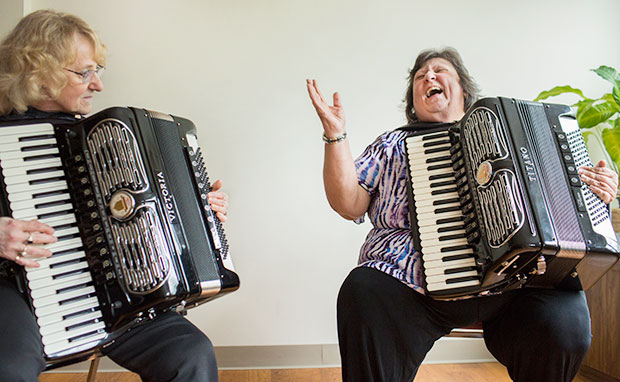AARP Hearing Center

By Natalie Missakian
Julie Cardona has nothing but praise for the care she received at Aurora Senior Living of Cromwell, the nursing home where she lived for more than a year while recovering from damaged lungs.
But despite the great nurses and staff, she chafed at the regimentation of the home’s schedule. She couldn’t leave without a family member signing her out. And Cardona couldn’t play her accordion at the times she wanted—a huge sacrifice for the lifelong musician.
“I really missed it,” she said.
Cardona, 66, now lives independently in a North Haven senior apartment complex, with home health aides visiting five days a week. She’s also back to doing what she loves: performing accordion concerts with her sister, Mary Tokarski.
Cardona is one of thousands of Connecticut nursing home residents who have successfully moved back into the community since 2008, thanks to a state and federal push away from high-cost institutional care toward more home- and community-based options.
State officials and advocates for older adults hope an innovative state program to “rebalance” long-term care spending to boost nursing home alternatives will mean more stories like Cardona’s.
“We really are at the leading edge of reconfiguring the way nursing homes can operate in the future if this works,” said Claudio Gualtieri, AARP Connecticut associate state director for advocacy.
In March, Gov. Dannel P. Malloy (D) announced that seven Connecticut nursing homes would share grants totaling $9 million to change their business models. The goal: providing choices for people who want long-term care in their homes and communities.
That means more in-home care, respite care and support to family caregivers, Gualtieri said. One facility, Hebrew Home in West Hartford, will receive up to $1.1 million to open a transitional wing for residents who can safely return to the community.
Rebuilding life skills
The home’s spokeswoman, Kristen Kinney, said the program will focus on life skills that patients often forget during nursing home stays, such as how to pay bills, read a bus schedule or write a shopping list.
“People are looking to receive services in more homelike settings, not institutional ones,” Kinney said. “We have long understood that we need to offer services in the places and ways in which seniors are looking to receive them.”
Nearly nine out of 10 older adults in Connecticut say they expect to age at home, according to University of Connecticut researchers.
But while spending on nursing homes has decreased since 2007, Connecticut still devotes close to 60 percent of its federal Medicaid long-term care dollars—around $1.8 billion—to institutional care. The grants will help consumers get more of what they want, said Dawn Lambert, project director for the state’s initiative.
Despite a growing elder population, Lambert said, demand for nursing homes is dropping. Since 2001, 35 skilled nursing facilities have closed in Connecticut, and projections show a surplus of more than 7,200 beds by 2025.
While it may seem contrary to the traditional mission of filling beds, forward-thinking nursing homes “see the writing on the wall” and know they must change to stay competitive, Gualtieri said.
The grants are funded through state bonds and an increase in federal Medicaid dollars under the Affordable Care Act, aimed at encouraging states to offer alternatives to nursing homes. The money will benefit nursing homes in Southington, New Haven, Torrington, Meriden, West Hartford and Fairfield. A second round of grant awards is expected this summer.
For more information about long-term care in Connecticut, call 211 or go to myplacect.org.
Natalie Missakian is a writer living in Cheshire, CT































































